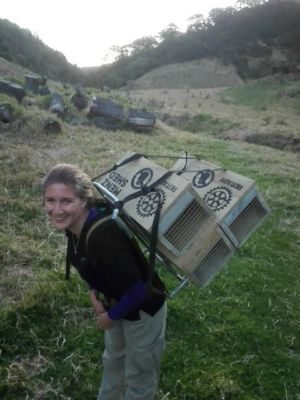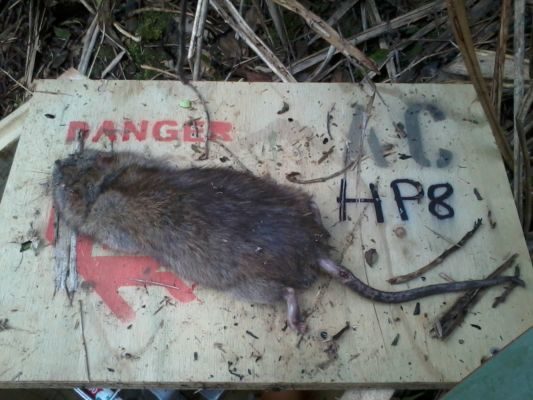This is not about an amazing scientific breakthrough in new toxins or lures. It doesn’t reveal a science-fiction-like technological invention or genetic modification to wipe out predators. Such things happen rarely in the world of science. But what the following research projects show is that the old methods (with some modern modifications and monitoring techniques) – do work and are effective at helping our native birds.
Predator control does make a difference to nesting success – and community group volunteers are effective predator controllers, according to recent research by John Innes, Carolyn King and others. What’s more, Carolyn King and Don Scurr from the University of Waikato’s ‘Centre for Biodiversity and Ecological Research’ have confirmed the effectiveness of a method for optimizing the number of rats controlled for volunteer effort – making the work more rewarding for those walking the trap lines.
In the first study, carried out in summer 2008/09 and published in 2015, researchers monitored the survival of natural and artificial tree-nests in forest remnants near Hamilton. Possum and ship rat numbers were also monitored. The experiment was replicated in forest blocks with and without pest control programmes.
Video footage revealed that possums and rats were indeed raiding both natural and artificial nests – as were harrier hawks, a natural predator of New Zealand’s smaller birds. Both eggs and chicks were predated.
Removal of possums and ship rats in December improved the 14-day probability of survival of artificial nests from P=0.63 (no predator control) to P=0.88 (predators controlled). In January the results were less clear – all blocks had approximately the same probability of survival at P=0.80 – an improvement for the non-treated forestry block and a decrease in effectiveness where predators were controlled.
Something else was apparently going on in the forests in January of that year. Ship rat numbers declined even in the non-controlled block, which would explain why nest survival improved there, even in the absence of predator control. The reason for the decline in rat numbers was not known.
The researchers concluded: “Our data from tawa (Beilschmiedia tawa) forest remnants confirm that control of ship rats and possums alone is sufficient to improve nesting success of small arboreal birds in North Island forests.”
The full report is published in the NZ Journal of Ecology and is freely available.
Predator control improves nesting success in Waikato forest fragments (2015)

Predator control does make a difference – but government agencies such as the Department of Conservation and regional councils simply don’t have the resources to carry out predator control everywhere. So are community volunteers effective pest controllers?
Counting rats caught is not enough to prove that pest control is working. What matters more is how many rats remain and how quickly the population is breeding to replace the numbers that were caught. For example, a small catch can mean effective pest control – if the 6 rats caught were the only ones there in the first place. An impressive catch tally of 100 dead rats may seem more effective than catching a mere 6 – but not if those 100 dead rats are only half of the rats present. The survivors will have less competition for food, breed rapidly and soon replace the 100 lost.
Carolyn King and Don Scurr from the University of Waikato studied the rat control work of the community led Pukawa Wildlife Management Trust, based on the south-western edge of Lake Taupo. At the time of the research (2012/2013), the Trust had a network of volunteers running 378 traps and 180 poison bait stations protecting about 50 ha around the village of Pukawa. Bait stations were used periodically in spring and summer, while traps were set permanently. In 10 years the permanently set traps had caught almost 5000 rats – but the group wanted to know whether their trapping was effective in decreasing overall black rat numbers and improving local biodiversity.
A series of actions were taken and their consequences measured by the researchers in order to determine the effectiveness of the volunteers’ work. These actions included testing the group’s rat-catching regime in a previously untrapped area (lots of rats were caught) and using tracking tunnels, wax tags, fake nests and cameras to detect the presence of rats in the Trust’s controlled area and the previously uncontrolled area (for comparison).
The results were a testament to the great work done by the Pukawa Wildlife Management Trust volunteer team:
“We showed that (1) the system used by Pukawa Wildlife Management Trust was effective in trapping rats where these were present in an unmanaged area; and (2) when this same proven system was applied inside the management area, it caught no rats at all. We used multiple independent methods to monitor the potential presence of trap/bait shy rats. They offered strong confirmation that very few rats were present but simply avoiding the traps and poison. We conclude that Pukawa Wildlife Management Trust’s management strategy, employing traps year-round plus poison from September onwards, had indeed reduced the potential number of rats present surviving in or reinvading the Pukawa bush in spring to very low levels… Our study provides heartening reassurance that the work of groups such as the Pukawa Wildlife Management Trust is effective in achieving this much-needed local protection.”
The full report is published in Conservation Evidence and is freely available:
Efficacy of a community-led rat control programme at Lake Taupo, New Zealand (2013)

It’s great to have scientific confirmation that the work of volunteers is definitely effective, worthwhile and much-needed. And finally, to make that effort less time-consuming and more rewarding, a technique to optimize the ratio of trapping to effort – prefeeding and trap pulsing.
Caroline King and Don Scurr tested the effectiveness of pre-feeding and trap pulsing with the help of the Pukawa Wildlife Management Trust volunteer group and found:
“In 20 traps locked-open and pre-fed with non-toxic pellets for five days, the same number of black rats was caught over the next 5 days as in 20 non pre-fed traps set for the whole 10 days (32 rats each). Allowing for successful traps being unavailable for an average of half a night each, the capture rate in the pre-fed traps was 47% over five days, more than double that in the non pre-fed traps set for twice as long (total 19% in 10 days).”
This research is also published in Conservation Evidence and is freely available through the University of Waikato’s ‘Research Commons’.

